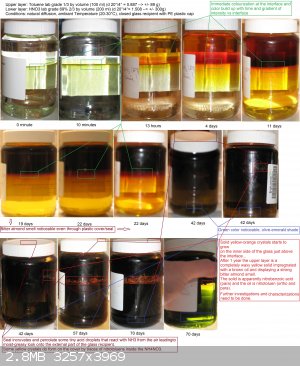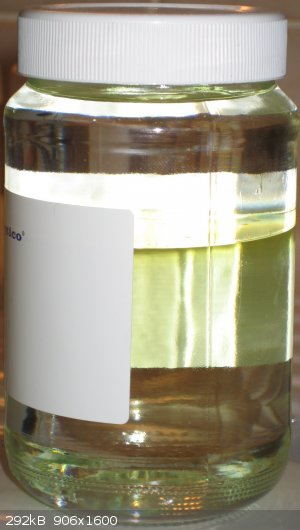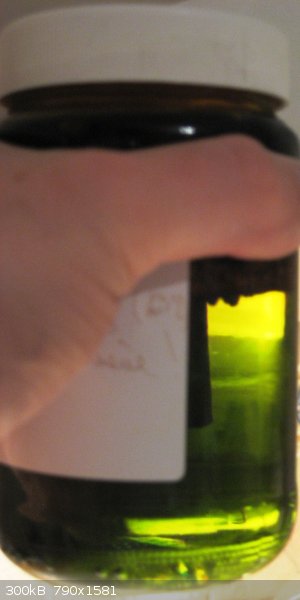Hawkguy
Hazard to Others
  
Posts: 326
Registered: 10-10-2014
Location: British Columbia (Canada eh!)
Member Is Offline
Mood: Body is Ready
|
|
Green Solution
I've noticed a green colour emerging after runaway nitrations, specifically regarding Picric Acid and Nitroglycerin. The colour is very light green
present in the solution after the reaction, and it is (sometimes?) destroyed by adding water. Any ideas?
[Edited on 14-6-2015 by Hawkguy]
|
|
|
Hennig Brand
International Hazard
    
Posts: 1284
Registered: 7-6-2009
Member Is Offline
Mood: No Mood
|
|
The most likely common link responsible is the sulfuric acid you are using which could have a contaminant causing the unusual color. I have noticed
the same thing myself at least a few times and was never really sure exactly what was going on. It never seemed to cause any problems as far as I
know. If it is drain cleaner sulfuric acid you are using it often has already been used to clean metals and things industrially from what I
understand.
"A risk-free world is a very dull world, one from which we are apt to learn little of consequence." -Geerat Vermeij
|
|
|
markx
National Hazard
   
Posts: 646
Registered: 7-8-2003
Location: Northern kingdom
Member Is Offline
Mood: Very Jolly
|
|
Most likely metallic impurities from acids or tools (if stainless mixer is used e.g. dissolved Fe, Ni, Cr can all impart a green coloration) that
change oxydation state or form complexes due to the released NOx or due to dilution if water is added. Organics can't be ruled out completely, but
since the coloration emerges with different nitration precursors I might be inclined towards the option of "metallic contaminants from the acid"....
Exact science is a figment of imagination.......
|
|
|
Microtek
National Hazard
   
Posts: 871
Registered: 23-9-2002
Member Is Offline
Mood: No Mood
|
|
It might also be HNO2 from partial reduction of the nitric acid. Solutions of NOx/HNO2 often takes on a light blue colour which could appear green,
particularly in conjunction with some of the yellowish run-away products.
|
|
|
kecskesajt
Hazard to Others
  
Posts: 299
Registered: 7-12-2014
Location: Hungary
Member Is Offline
Mood: No Mood
|
|
It is also noticable after ethanol amd isopropanol nitraton.I'm using technical(not plumber grade H2SO4).Maybe nitroform or TNM.
|
|
|
PHILOU Zrealone
International Hazard
    
Posts: 2893
Registered: 20-5-2002
Location: Brussel
Member Is Offline
Mood: Bis-diazo-dinitro-hydroquinonic
|
|
Quote: Originally posted by Microtek  | | It might also be HNO2 from partial reduction of the nitric acid. Solutions of NOx/HNO2 often takes on a light blue colour which could appear green,
particularly in conjunction with some of the yellowish run-away products. |
I would go for this explaination because I have noticed the green colour while nitrating toluene with only lab grade 69% HNO3 in a glass jar with a
plastic (thus no metals presents)!
Nor toluene, nor HNO3 had a yellow or green tinge (colourless at first).
The green colour developped with time and with NxOy.
It disappear when dilluted or when let open for a big while.
In many occasions organic nitroso compounds do form colorized dimers...
PH Z (PHILOU Zrealone)
"Physic is all what never works; Chemistry is all what stinks and explodes!"-"Life that deadly disease, sexually transmitted."(W.Allen)
|
|
|
GrayGhost
Harmless

Posts: 41
Registered: 13-5-2015
Location: Sudacaland
Member Is Offline
Mood: No Mood
|
|
Long, long time ago I´m preparate picric acid from nitric diluited, benzene ( was OTC in thats times) and mercury nitrate like catalyst.
Was yellow colour and making stain yellow my finger several days.
|
|
|
PHILOU Zrealone
International Hazard
    
Posts: 2893
Registered: 20-5-2002
Location: Brussel
Member Is Offline
Mood: Bis-diazo-dinitro-hydroquinonic
|
|
Quote: Originally posted by PHILOU Zrealone  | Quote: Originally posted by Microtek  | | It might also be HNO2 from partial reduction of the nitric acid. Solutions of NOx/HNO2 often takes on a light blue colour which could appear green,
particularly in conjunction with some of the yellowish run-away products. |
I would go for this explaination because I have noticed the green colour while nitrating toluene with only lab grade 69% HNO3 in a glass jar with a
plastic (thus no metals presents)!
Nor toluene, nor HNO3 had a yellow or green tinge (colourless at first).
The green colour developped with time and with NxOy.
It disappear when dilluted or when let open for a big while.
In many occasions organic nitroso compounds do form colorized dimers... |
Here is an overview of a time-lapse sequence of pictures of a mix of 1/3 toluen and 2/3 of HNO3 69%, both lab grade. This shows the special green
color.

A closer look at the first and last pictures:


The last picture is emerald green, but there is no metallic contamination possible ... so the colour can only come from nitroso compounds.
Conclusions:
In books and at school and at university we are all told that aromatic nitration only occure when NO2(+) is present and for this that concentrated
nitric acid is needed or concentrated sulfuric acid with nitrate salt or less concentrated nitric acid.
Here the experiment shows clearly that at contact interface without heating and in presence of a lot of water (31%) there is immediate reaction
between HNO3 and toluen with natural diffusion.
--> Nothing is better than experimentation even if books says otherwise!
Formation of nitrotoluens is proven by the bitter almond smell and orange-brown colour.
Big surprise is observed by apparition of yellow-orange crystals....and after a year or so the organic upper layer is completely waxy-solid wetted by
nitrotoluens.
By melting point comparison with known melting point compounds it was shown to be more probably para-nitrobenzoic acid.
Thus a one pot synthetic pathway to that compound  ... ...
Note that nitration of benzoic acid needs concentrated acids and yield meta-nitrobenzoic acid.
Further investigation must be done about yield and proportion of the various products and purity.
PH Z (PHILOU Zrealone)
"Physic is all what never works; Chemistry is all what stinks and explodes!"-"Life that deadly disease, sexually transmitted."(W.Allen)
|
|
|
biomechem
Unregistered
Posts: N/A
Registered: N/A
Member Is Offline
|
|
A friend of mine who is not a chemist at all told me about one weird method. He weighted about 40 ml of toluene, 50 g of KNO3 and 50 ml of
H2SO4. He put a KNO3 over toluene in the fridge, and separately sulfuric acid. When everything was chilled, he kept
adding acid in 5 portions, but after second one the mixture was already nice orange and after mixing it started boiling. After third addition
everythink turned dark orange and the mixture was boiling and fuming. This was the moment he knew he did a mistake and used 2x too much acid. After
about a half an hour he added water and wet organic layer
was about 50 ml.
In his second attempt he used more toluene than needed, which gave him pale yellow sln. After purification by distillation he recovered toluene, and
oily yellow sln remained in the flask. Product was then separated by cooling in a fridge. He received almost white crystalls of p-NT (and probably
DNT), and oil.
Unfortunately he didn't take any photos, what's worse he couldn't check how pure the product is and what are the sideproducts. What do you think about
this method? It seems that yields are almost quantitive, moreover rxn is fast, and cooling seems to be not neccesary.
Do you think that cooling it in dry ice added in the rxn flask is a good idea, or it can promote side-reactions?
And the most important question, does another experiment made in anhydrous conditions denies "classic" mechanism of the rxn?
[Edited on 3-3-2017 by biomechem]
|
|
|
Texium
|
Thread Moved
3-3-2017 at 15:13 |